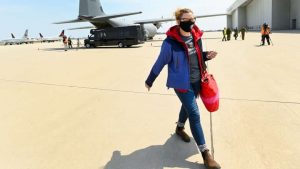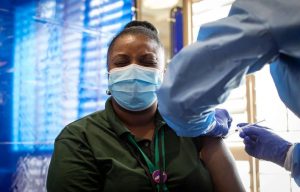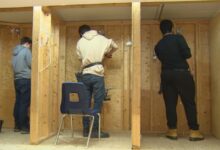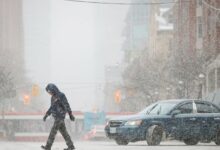Ontario sees 3,265 new COVID-19 cases as vaccine appointments open to 45+ in hot spots

Ontario reported another 3,265 cases of COVID-19 and 29 more deaths linked to the illness on Tuesday, as the province announced more residents of hot spot communities and some child-care workers will be able to book appointments for a vaccine.
Ontario requests help from Canadian Armed Forces as critical care COVID-19 cases surge
The total number of cases is the fewest on a single day since April 7, though they come as labs completed just 34,000 tests and logged a provincewide positivity rate of 10.2 per cent.
As of yesterday, there were 875 COVID-19 patients being treated in critical care — two fewer than the day before, marking the first time that figure has dropped since March 22. It is far too early to draw any inferences from the slight one-day drop, though.
Critical Care Services Ontario, a government agency that maintains a tally of hospitalizations, said 59 more people were admitted to intensive care units yesterday.
Of the patients in ICUs, 589 required a ventilator to breathe, down from 605 the day before, according to the health ministry.
Notably, the overall number of hospitalizations climbed to 2,336, up from 2,271 the day before.
The new cases in today’s provincial update include:
- 1,044 in Toronto
- 673 in Peel Region
- 452 in York Region
- 171 in Durham Region
- 150 in Ottawa
- 138 in Halton
- 119 in Hamilton
The seven-day average of daily cases is down to 3,888, its lowest point in 10 days.
Another 3,908 cases were marked resolved in today’s provincial report. There are about 39,914 confirmed, active infections in Ontario.
The 29 additional deaths push the official toll to 7,964. The seven-day average of deaths rose to 29.6, a new high for the third wave of the pandemic.
Among those Ontarians who recently died with COVID is a 13-year-old girl from Brampton.
Dr. Dirk Huyer, Ontario’s chief coroner, noted in an interview with CBC News Network yesterday that least 27 people with COVID — many of them under the age of 60 — have died suddenly at home throughout April.
Ottawa declines proposed changes to sick leave program
Also this morning, the federal government rejected a proposal from Premier Doug Ford and his cabinet to supplement the existing Canada Recovery Sickness Benefit (CRSB) rather than create a provincially-run program.
The province offered in a letter to double the amount of financial support to eligible workers from $500 to $1,000 per week and cover 100 per cent of the additional cost — as long as Ottawa administers the payments.
Ford and top government officials have been under increasing pressure to implement a provincially-mandated paid sick leave program as the third wave of COVID-19 continues to put an unequal burden on essential and low-wage workers. The Progressive Conservatives cut Ontario’s own sick leave program after they formed government in 2018.
Last week, the province relented and signalled it would announce “enhancements” to the federally-run CRSB, which has been criticized as too complicated and insufficient in many instances. Ford promised “one of the best” sick leave programs in North America at a news conference last Thursday.
Federal Finance Minister Chrystia Freeland rejected the proposal.
“When Ontario is ready to mandate sick leave in provincially-regulated businesses, as we have done for federally-regulated businesses, we will be there to help,” her office said in a statement.
“In fact, the wage subsidy was designed — and is already set up — to provide employers with financial support to pay the wages of workers who are on sick leave.”
CRSB is intended for those “who would otherwise fall through the cracks,” the statement added.
The federal response puts Ford’s government in a difficult position. In a statement late last week, Ford said it “would not impose any additional burden on the backs of Ontario businesses that have been ravaged by the COVID-19 pandemic.”
Furthermore, Ford’s government has repeatedly shot down or voted against opposition proposals that would have seen employers reimbursed by the province.
Child-care workers to be eligible for vaccines
Meanwhile, as of today, those aged 45 and older who live in one of 114 designated hot spot postal codes can begin booking appointments for a shot through either Ontario’s online portal or call centre, or via their local public health unit.
Importantly, residents aged 18 and older who live in the hot spot areas — which are spread out over 13 public health units — are also eligible for vaccines, though those under 45 can only access a shot through a mobile or pop-up clinic.

Meanwhile, child-care workers will be able to get an appointment starting Thursday morning. Eligible workers will get a letter from their employer that they will need to have handy at the time of booking and at their appointment, the province said in a news release.
Vaccines will also be made available to those who work in unlicensed child-care settings in the coming weeks, according to the province.
Public health units collectively administered 94,819 vaccines yesterday, the Ministry of Health said. Ontario has used 4,791,030, or slightly more than 91 per cent, of the 5,248,345 doses it has received to date.
Provincial health officials are expecting several significant shipments this week: 396,630 doses of the Pfizer vaccine and 116,700 doses of the single-shot Johnson & Johnson vaccine. A delivery of 389,000 AstraZeneca doses that were scheduled to land last week has still not arrived, and it is unclear when it will.
Late last week, Ontario’s COVID-19 science advisory table recommended that the province revise its vaccine rollout plan to divert up to 50 per cent of available vaccine doses to 74 hot spot postal codes. The current strategy allows for 25 per cent of total doses to go to 114 designated hot spots.
In a brief posted online, the science table said that the shift in approach would also speed vaccines to essential workers, and could potentially prevent up to 20 per cent of forecasted infections among those aged 16 to 59 years old.
Health Minister Christine Elliott said yesterday that the province is considering the recommendation and will have a decision in the coming days.
Ahead of any official change, local officials in Toronto and Peel Region confirmed they would begin directing more doses to hot spots in their respective health units as supply ramps up in early May.
There are 54 hot spot postal codes in Toronto and 25 in Peel.








Redes Sociais - Comentários